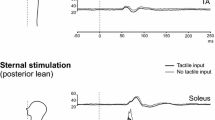Summary
Postural reactions to disruptions of stance are rapid and automatic in both quadrupeds and bipeds. Current evidence suggests that these postural responses are generated by the central nervous system as patterns involving muscle synergies. This study attempted to test this hypothesis of a centrally generated postural mechanism by determining whether the same postural response could be evoked in the freely-standing cat under two different biomechanical conditions. The present work is an extension of previous experiments in which the stance of cats was perturbed by a horizontal translation of the supporting surface in the anterior and posterior directions (Rushmer et al. 1983). We now tested whether simple rotation of the metacarpo- and metatarsophalangeal (M-P) joints that mimics the digit rotation occurring during platform translation, was sufficient to evoke the translation postural response. The rotational perturbations were biomechanically different from translations in that the rotation did not cause displacement of the centre of mass of the animal, nor did it result in any significant movement about any but the M-P joints. Even so, rotational perturbations did evoke the appropriate translational muscle synergies in all four animals. Both plantar flexion rotation and headward translation activated the posterior hindlimb synergy (which included gluteus medius, semitendinosus and lateral gastrocnemius). Similarly, dorsiflexion rotation and tailward translation both activated the same anterior hindlimb synergy (iliopsoas, vastus lateralis and tibialis anterior) together with the forelimb synergy. The postural responses elicited by rotational perturbations were biomechanically inappropriate, and caused the animal to displace its own centre of mass away from the stable, control position. The most striking finding was that the group of muscles in which the medium latency postural response was evoked was different than the group from which short latency reflex responses were elicited. These data support the hypothesis that postural reactions are not merely reflex responses to local sensory inputs associated with the perturbation but, instead, represent a centrally generated response, with the muscle synergy being the controlled unit.
Similar content being viewed by others
References
Babinski J (1899) De l'asynergie cérébelleuse. Rev Neurol 7: 806–816
Baldissera F, Hultborn H, Illert M (1981) Integration in spinal neuronal systems. In: Brooks VB (ed) Handbook of physiology, Sect. 1, Vol II, Am Physiol Soc, Bethesda, pp 509–595
Bernstein N (1967) The coordination and regulation of movements. Pergamon Press, Oxford, pp 1–196
Cordo PJ, Nashner LM (1982) Properties of postural adjustments associated with rapid arm movements. J Neurophysiol 47: 287–302
Coulmance M, Gahery Y, Massion J, Swett JE (1979) The placing reaction in the standing cat: a model for the study of posture and movement. Exp Brain Res 37: 265–281
Diener HC, Dichgans J, Bootz F, Bacher M (1984) Early stabilization of human posture after a sudden disturbance — influence of rate and amplitude of displacement. Exp Brain Res 56: 126–134
Dufossé M, Macpherson JM, Massion J (1982) Biomechanical and electromyographical comparison of two postural supporting mechanisms in the cat. Exp Brain Res 45: 38–44
Dunbar DC, Horak FB, Macpherson JM, Rushmer DS, Russell CJ (1983) Postural correction in feline and human subjects during both quadrupedal and bipedal stance. Neurosci Abstr 9: 63
Eccles JC, Eccles RM, Lundberg A (1957) The convergence of monosynaptic excitatory afferents onto many different species of alpha motoneurons. J Physiol (Lond) 137: 22–50
Eccles RM, Lundberg A (1958) Integrative pattern of Ia synaptic actions of motoneurons of hip and knee muscles. J Physiol (Lond) 144: 271–298
Gelfand IM, Gurfinkel VS, Tsetlin ML, Shik ML (1971) Problems in the analysis of movements. In: Gurfinkel VS, Formin SV, Tsetlin ML (eds) Models of the structural-functional organization of certain biological systems. MIT Press, London, pp 329–345
Greene PH (1972) Problems of organization of motor systems. Prog Theor Biol 2: 303–338
Haxton HA (1947) Muscles of the pelvic limb. Anat Rec 98: 337–346
Horak FB, Nashner LM (1983) Two distinct strategies for stance posture control: adaptation to altered support surface configurations. Neurosci Abstr 9: 65
Kots YM, Krinskiy VI, Naydin VL, Shik ML (1971) The control of movements of the joints and kinesthetic afferentation. In: Gurfinkel VS, Formin SV, Tsetlin ML (eds) Models of the structural-functional organization of certain biological systems. MIT Press, London, pp 373–381
Nashner LM (1977) Fixed patterns of rapid postural responses among leg muscles during stance. Exp Brain Res 30: 13–24
Rushmer DS, Russell CJ, Macpherson JM, Phillips JO, Dunbar DC (1983) Automatic postural responses in the cat: responses to headward and tailward translation. Exp Brain Res 50: 45–61
Szentágothai J, Arbib MA (1974) Conceptual models of neural organization. Neurosci Res Prog Bull 12: 307–510
Traub MM, Rothwell JC, Marsden CD (1980) Anticipatory postural reflexes in Parkinson's disease and other akinetic-rigid syndromes and in cerebellar ataxia. Brain 103: 393–412
Author information
Authors and Affiliations
Additional information
Supported by NIH grants NS19484 and RR05593 as well as Good Samaritan Hospital
Rights and permissions
About this article
Cite this article
Macpherson, J.M., Rushmer, D.S. & Dunbar, D.C. Postural responses in the cat to unexpected rotations of the supporting surface: evidence for a centrally generated synergic organization. Exp Brain Res 62, 152–160 (1986). https://doi.org/10.1007/BF00237411
Received:
Accepted:
Issue Date:
DOI: https://doi.org/10.1007/BF00237411




